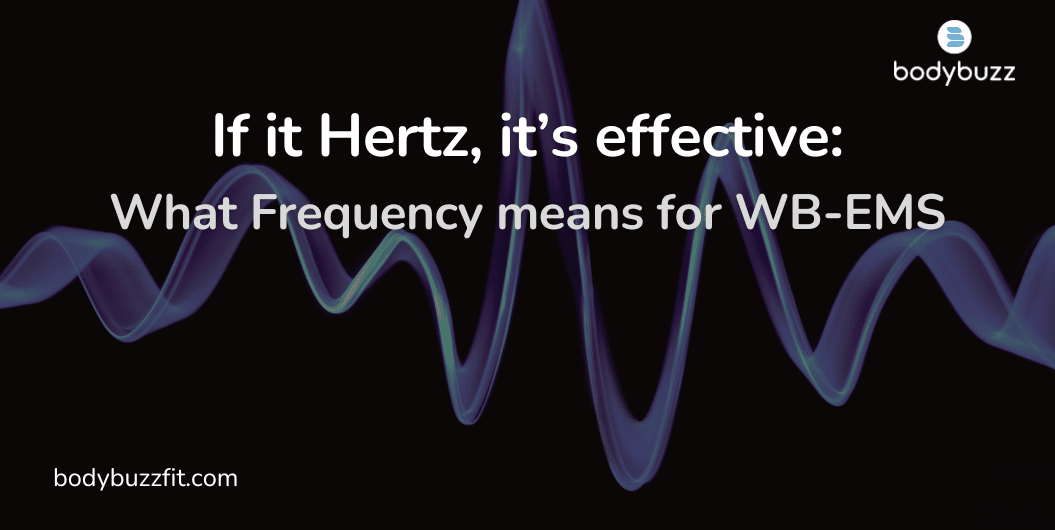If it Hertz, it’s Effective: What Frequency means for WB-EMS
Whole-body electrical muscle stimulation (WB-EMS) is a training method that utilizes electrical impulses to stimulate muscles throughout the body. One of the main parameters we can control during an EMS workout is frequency.
Frequency refers to the rate at which the electrical impulses are delivered to the muscles. The frequency setting determines how many times the muscles receive electrical stimulation per second. The number of stimulations per second, however, does not correspond to the number of muscle contractions. We explain this in our blog about tetanic contraction.
Here’s a detailed explanation of how frequency works in WB-EMS:
WB-EMS works on the principle of electrical muscle stimulation (EMS), which involves the application of electrical impulses to cause muscle contractions. These impulses mimic the natural process of muscle activation during physical exercise.
Electrical impulses: The device used in WB-EMS generates electrical impulses, which are delivered to the muscles via electrodes placed on the major muscle groups: quadriceps, latissimus dorsi, pectoralis major, biceps, triceps, glutes, hamstrings, lower back, and traps. Some suits will include a couple of other muscles. The impulses stimulate the motor nerves, causing the muscles to contract just like the nervous system would.
Frequency refers to the number of electrical impulses delivered per second, measured in Hertz (Hz). In WB-EMS, frequency settings typically range from a few Hz to several tens of Hz. Common frequencies used in WB-EMS sessions can vary from 5 Hz to 100 Hz.
Muscle response: The frequency of electrical stimulation directly influences the response of the muscles. Different frequencies target different types of muscle fibers and elicit varying degrees of muscle contraction.
Type of muscle fibers: Muscles consist of different types of muscle fibers, primarily classified as slow-twitch (Type I) and fast-twitch (Type II) fibers. Slow-twitch fibers are more resistant to fatigue and are primarily activated during endurance activities, while fast-twitch fibers are responsible for explosive movements and are more prone to fatigue.
Frequency and Muscle Fiber Activation:
Low Frequencies (5-30 Hz): These frequencies primarily target slow-twitch muscle fibers, promoting endurance and metabolic adaptation. They are suitable for longer-duration WB-EMS sessions aimed at improving endurance and promoting fat metabolism.
Medium Frequencies (30-50 Hz): Medium frequencies mostly activate both slow-twitch and fast-twitch muscle fibers, providing a balance between endurance and strength training effects. This range is often used for general fitness.
High Frequencies (50-100 Hz): High frequencies predominantly target fast-twitch muscle fibers, eliciting strong muscle contractions and promoting strength and power development. These frequencies are typically used for short-duration, high-intensity training sessions aimed at building muscle mass and strength.
Note: these ranges are not strict cut-offs, and EMS workouts will stimulate slow-twitch muscle fibers even at higher frequencies.
At around 20+ Hz, the muscle goes into something called tetanic contraction, where the frequency of stimulation is so high the muscle doesn’t have time to relax so it stays contracted. Claims made that WB-EMS produces 85 contractions per second because it’s set at 85 Hz are completely false.
Individual variation: The optimal frequency for WB-EMS training may vary among individuals based on factors such as fitness level, training goals, muscle fiber composition, and tolerance to electrical stimulation. We adjust the frequency settings based on individual needs and responses.
Programming: WB-EMS sessions are typically programmed to include a combination of different frequency settings, pulse widths, and intensities to effectively target specific muscle groups and training objectives. The duration and intensity of the sessions are also adjusted based on the individual’s fitness level and goals.
Frequency plays a crucial role in WB-EMS training by determining the type and intensity of muscle contractions elicited during the session. By adjusting the frequency settings, we can tailor the training program to achieve specific fitness goals, whether it’s improving endurance, strength, muscle mass, or overall fitness.
If you want to learn more about EMS, book a free consultation with me here: https://calendly.com/conradfitness/30min. You can also make an appointment to book an intro session at our Newport Beach studio.
Conrad
Managing Director
Bodybuzz

